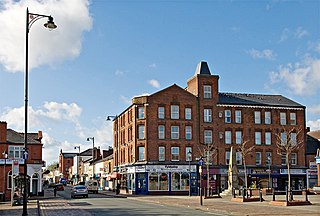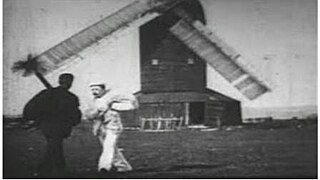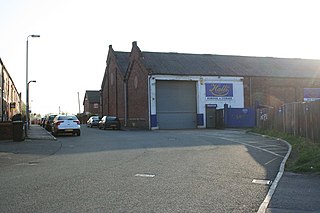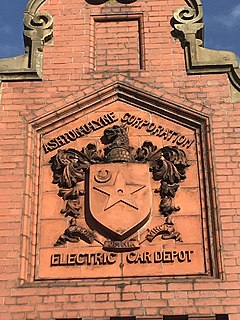The year 1904 in film involved some significant events.
The year 1901 in film involved some significant events.

Wigan Warriors R.L.F.C. is a professional rugby league club in Wigan, Greater Manchester, England, which competes in the Super League.
The Mitchell & Kenyon film company was a pioneer of early commercial motion pictures based in Blackburn in Lancashire, England, at the start of the 20th century. They were originally best known for minor contributions to early fictional narrative film and Boer War dramatisation films, but the discovery in 1994 of a hoard of film negatives led to restoration of the Mitchell & Kenyon Collection, the largest surviving collection of early non-fiction actuality films in the world. This collection provides a fresh view of Edwardian era Britain and is an important resource for historians.
Sagar Jones Mitchell was a pioneer of cinematography in Blackburn, Lancashire, England.
James Kenyon was a businessman and pioneer of cinematography in Blackburn, Lancashire, England.
The Lost World of Mitchell & Kenyon is a BBC documentary series produced in conjunction with the British Film Institute. Three one-hour episodes were broadcast on BBC One in January 2005 and released on Region 2 DVD soon after. The episodes are titled as follows: 1. Life and Times 2. Sport and Pleasure 3. Saints and Sinners
The actuality film is a non-fiction film genre that, like the documentary film, uses footage of real events, places, and things. Unlike the documentaries, actuality films are not structured into a larger argument, picture of the phenomenon or coherent whole. In practice, actuality films preceded the emergence of the documentary. During the era of early cinema, actualities—usually lasting no more than a minute or two and usually assembled together into a program by an exhibitor—were just as popular and prominent as their fictional counterparts. The line between "fact" and "fiction" was not as sharply drawn in early cinema as it would become after the documentary came to serve as the predominant non-fiction filmmaking form. An actuality film is not like a newspaper article so much as it is like the still photograph that is published along with the article, with the major difference being that it moves. Apart from the traveling actuality genre, actuality is one film genre that remains strongly related to still photography.

Tyldesley is a town in the Metropolitan Borough of Wigan in Greater Manchester, England. Within the boundaries of the historic county of Lancashire, it is north of Chat Moss near the foothills of the West Pennine Moors, 7.7 miles (12.4 km) southeast of Wigan and 8.9 miles (14.3 km) northwest of Manchester. At the United Kingdom Census 2001, the Tyldesley built-up area, excluding Shakerley, had a population of 16,142.

Billy Liar is a 1963 British CinemaScope comedy-drama film based on the 1959 novel by Keith Waterhouse. Directed by John Schlesinger, it stars Tom Courtenay as Billy and Julie Christie as Liz, one of his three girlfriends. Mona Washbourne plays Mrs. Fisher and Wilfred Pickles plays Mr. Fisher. Rodney Bewes, Finlay Currie and Leonard Rossiter also feature. The Cinemascope photography is by Denys Coop and Richard Rodney Bennett supplied the score.

Wigan is a large town in Greater Manchester, England, on the River Douglas. The town is situated midway between the two cities of Manchester, 16 miles (25.7 km) to the south-east, and Liverpool, 17 miles (27 km) to the south-west. Bolton lies 10 miles (16 km) to the north-east and Warrington 12 miles (19 km) to the south. Within the boundaries of the historic county of Lancashire, Wigan is the largest settlement in the Metropolitan Borough of Wigan and is its administrative centre. The town has a population of 107,732 and the wider borough of 330,713.

The BFI National Archive is a department of the British Film Institute, and one of the largest film archives in the world. It was founded as the National Film Library in 1935; its first curator was Ernest Lindgren. In 1955, its name became the National Film Archive, and, in 1992, the National Film and Television Archive. It was renamed BFI National Archive in 2006.

The Kiss in the Tunnel, also known as A Kiss in the Tunnel, is a 1899 film British short silent comedy film, produced and directed by George Albert Smith, showing a couple sharing a brief kiss as their train passes through a tunnel, which is said to mark the beginnings of narrative editing. The film is the first to feature Laura Bayley, Smith's wife.

The Miller and the Sweep is a 1898 British short black-and-white silent comedy film, directed by George Albert Smith, featuring a miller carrying a bag of flour fighting with a chimney sweep carrying a bag of soot in front of a windmill, before a crowd comes and chases them away. The film, according to Michael Brooke of BFI Screenonline, "was one of the first films made by G.A. Smith, shortly after he first acquired a camera," and is also, "one of the earliest films to show a clear awareness of its visual impact when projected."

You Lucky People! is a 1955 British comedy film directed by Maurice Elvey and starring Tommy Trinder, Mary Parker and Dora Bryan. Originally titled Get Fell In, the film was renamed to match Trinder's familiar catchphrase. It was shot in a rival French process to CinemaScope, called 'CameraScope', with the attendant publicity describing "the first feature to be made with an anamorphic lens in black and white! It's a camerascoop!". It was shot at Beaconsfield Studios near London with sets designed by the art director Ray Simm.

Morecambe Church Lads' Brigade at Drill is a 1901 British short silent documentary film, directed by James Kenyon and Sagar Mitchell, showing the parade drill of the Morecambe Church Lads' Brigade on 3 July 1901. The film, which was premiered at the Winter Gardens in Morecambe on the same day it was filmed, was popular and went on to be shown at other venues in the North of England.

Wigan Corporation Tramways operated a tramway service in Wigan, England, between 1901 and 1931. The first tramway service in the town was run by the Wigan Tramways Company, whose horse trams began carrying passengers in 1880. They began replacing horses with steam tram locomotives from 1882, but the company failed in 1890 when a Receiver was appointed to manage it. The Wigan & District Tramways Company took over the system in 1893 and ran it until 1902. Meanwhile, Wigan Corporation were planning their own tramway system, obtaining an authorising Act of Parliament in 1893, and a second one in 1898. This enabled them to build electric tramways, and in 1902, they took over the lines of the Wigan & District Tramways Company.

Kidnapping by Indians is a 1899 British silent short Western film, made by the Mitchell and Kenyon film company, shot in Blackburn, England. It is believed to be the first dramatic film in the Western genre, pre-dating Edwin S. Porter's The Great Train Robbery by four years.

Scotforth is a civil parish in City of Lancaster district, Lancashire, England. It does not include the suburb Scotforth, but is further south, comprising areas to the west, north and north-east of Lancaster University. It has an area of 645.86 hectares.

The history of trams in Ashton-under-Lyne date back to 1878, through the Manchester Carriage & Tramways Company. These trams were horse-drawn trams and began operation in 1881, between Stalybridge & Ashton-under-Lyne. The route began at Stalybridge's town hall, stopping at Ashton-Under-Lyne and terminating at the Snipe Inn at Ashton-Under-Lyne/Audenshaw boundary line. The Stalybridge, Hyde, Mossley & Dukinfield Tramways & Electricity Board provided tram operations in the wider Tameside region.













